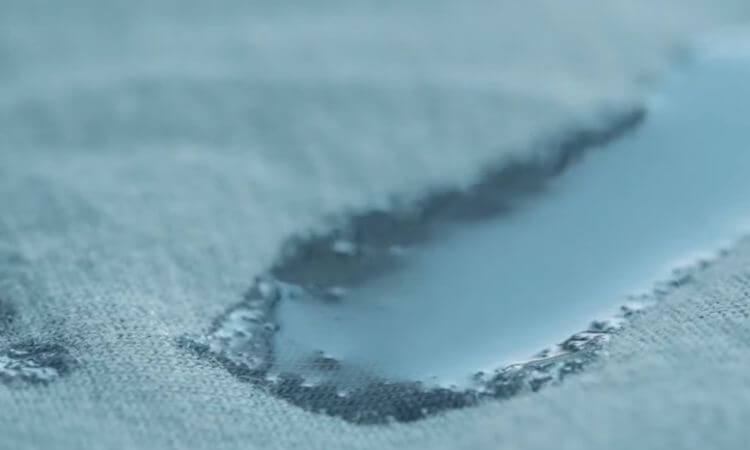If you buy via any of our links, there will be no additional cost to you, and we will receive a tiny commission. More information is available on our Affiliate Disclosure page.

Which is Warmer Cotton or Polyester?
Which is warmer cotton or polyester? Polyester is warmer than cotton because polyester can wick away sweat and also keep out wind and moisture, which keeps us warm.
Cotton, a natural fiber grown on cotton cultivation, is frequently chosen for clothes for its warm and cozy feel. It is very airy, letting it wick away moisture and keep you warm.
Cotton can become uneasy when wet, so loose-fitting clothing is a good idea.

Polyester, on the other hand, is a human-made synthetic fiber. It’s common in winter clothing like socks, t-shirts, and sweaters.
Polyester is renowned for its insulating capabilities, making it an excellent selection in colder weather. Unlike cotton, polyester dries quickly and does not absorb moisture, making it ideal for outdoor activities.

Which is warmer cotton or polyester, depends upon your choices and particular demands. Cotton gives comfort and flexibility, yet polyester offers insulation and strength.
Understanding the unique features of each fabric can assist you in making the correct choice based on what’s most important to you.
Is Polyester Warmer than Cotton?
Polyester fabric outlasts cotton fabric. Tents, coats, jackets, sleeping bags, and pillows are all made from polyester fabric.
Polyester becomes more durable when combined with other fibers like – nylon, wool, silk, or cotton.
Polyester may remove moisture from the body, which is helpful in cold and moist conditions because it keeps you dry while keeping you warm.
In colder climates, polyester holds heat better than cotton. It draws heat closer to your body, keeping you warm.
Cotton is an organic and airy fabric. It is a light, easy-to-wear stuff and suited for both hot and cold weather.
Cotton is a breathable fiber that takes on sweat well. It dries fast and does not trap moisture like synthetics. Women wear it because it is comfortable and soft, especially in warmer climates.
Cotton is more ventilating than polyester, allowing more air to circulate through your body. In hot weather, this will help you to keep cool.
However, some factors, such as the fabric’s weight, the fabric, the weave of the fabric, and the amount of dampness in the material, may impact how warm it is.
A heavier fabric is generally warmer than a lighter fabric, and a tightly knitted item is hotter than a loosely knitted one.
Also, when any cloth is wet, it doesn’t stay as warm as when it is dry.
Here is a table summarizing which is warmer cotton or polyester, in terms of warmth:
| Feature | Polyester | Cotton |
| Warmth | Warmer | Less warm |
| Moisture-wicking | Good | Poor |
| Breathability | Poor | Good |
| Durability | Good | Good |
| Cost | Lower | Higher |
To summarize, cotton can be warmer than polyester when dry but loses its insulation capabilities when wet. Polyester may not be as warm when dry, but it maintains its insulation even when wet.
Polyester is the more warm preferred in cold weather. Cotton is the better option in hot weather.
The specific conditions and your preferences will determine which material you use.
What is Polyester Made of?
Polyester is one of the most versatile materials ever discovered. It’s used for making clothing, carpets, upholstery, furniture, packaging, paper, and other consumer goods.
You will find polyester in everything from food packaging to shampoo bottles.
Polyester was invented in 1939 and has increased in usage and popularity since then. PET stands for polyethylene terephthalate.
Polyester is an artificial fiber composed of petroleum, air, and water. Polyester is mainly made from mono ethylene glycol (MEG) and purified terephthalic acid (PTA).
PTA is a colorless, odorless, and tasteless petroleum-derived solid. MEG is a colorless, odorless, and sweet-tasting petroleum liquid.
PET is melted and then forced through tiny holes (spinnerets) to form continuous filaments to make polyester fibers. The size and shape of the spinnerets determine the fiber’s shape and length.
After that, the fibers are cooled and stretched to give them their final properties.
Polyester is an adjustable fiber with a wide range of applications. It is durable and easy to maintain. Polyester is also a low-cost fiber, making it an attractive choice for apparel, household goods, and commercial goods.

What is Cotton Made of?
Cotton is a natural fiber collected from the cotton plant, scientifically known as Gossypium. The cotton plant produces fluffy white fibers, harvested and processed to make the cotton material that we are familiar with.
Cotton is composed of cellulose, a complex carbohydrate in plant cell walls. These are long, thin, and twisted cells. Cotton bolls (seed pods) burst open when mature, revealing the fibers within.
Cotton bolls are picked by hand or machine once plants have reached maturity. After harvesting, the cotton fibers are separated from the seeds and others by ginning.
Ginning involves machines that remove the cotton fibers from the seeds by combing or spinning the material. The fibers are cleaned, carded, and cut to create yarn or thread.
This yarn can now produce various cotton products such as clothing, towels, bed sheets, and more.

Is Cotton or Polyester Warmer in Winter?
Which is warmer cotton or polyester for winter? Both of these are popular fabrics for winter clothing, but their characteristics differ, so they’re ideal for various uses.
Polyester is a synthetic substance widely recognized for its wicking away moisture and fast-drying features. It is the best choice for people who sweat a lot and for sportswear.
Polyester is also remarkably inexpensive and easy to look after. It is slower to breathe than cotton and may feel sticky or uneasy in cold weather.
Cotton is a plant-based fiber known for its softness and ventilation. It is the best choice for layering in the winter, as it may hold heat to keep you warm. Ths is also flexible, which may help keep moisture at bay, keeping you cool and comfortable.
Cotton can be slow to dry, which can be a problem if you get wet in the winter.
So, which is preferable in the winter? It will vary by individual desires and needs. Polyester is a good choice if you want a moisture-wicking and quick-drying fabric.
Cotton is the best fabric to make the most of if you want something comfortable and ventilated.
The best fabric for winter clothing is the one that makes you feel hot and meets what you need. If you’re confused about what kind of cloth you should begin with, try polyester and cotton items one after another.
Which is Warmer Cotton or Polyester for Hot Weather?
For Summer Clothing:
Choose light-colored fabrics that reflect heat and keep you cool. Wear loose-fitting clothing for the air to pass through and help you stay cool.
You should avoid synthetic materials because they may keep heat and moisture. Find clothes created using organic fibers, such as cotton, linen, or silk.
Look for fabrics that are both airy and absorbent.
A few things should be considered when deciding between polyester and cotton for summer wear.
Cotton has become recognized as the best fabric for summer wear. It is airy and lightweight and ideal for hot and humid days. Cotton also dissolves moisture well, keeping you cool and more comfortable.
On the other hand, polyester is an artificial material that is not as airy as cotton. It can also hold heat and moisture, making you feel hotter and more sticky in hot weather.
However since polyester is more wrinkle-resistant and dries faster than cotton, it may be a better choice for some people.


Which Fabric Breathes Better, Polyester or Cotton?
Cotton tends to be more airy than polyester. Cotton is a natural material that lets air flow freely and gives you good ventilation, making it a perfect choice for air-breathable clothing.
The cotton fibers’ system allows for better airflow and moisture retention, keeping you cool and happy.
On the other hand, polyester is an artificial material that is less airy. It lacks cotton’s natural airiness and can hold heat and moisture with the skin.
Polyester fibers are not as effective at allowing ventilation, making them less flexible and almost less pleasurable to wear.
While polyester has wicks away moisture characteristics that aid in removing sweat and speedy drying, it doesn’t have cotton’s breathability.
Polyester become common in sportswear and activewear, where moisture control is vital, but cotton is preferred for everyday wear and hot weather because it breathes well.
Cotton is the better choice between polyester and cotton for breathability. Its natural fibers promote better airflow and ventilation, making it more cozy and breathable.
What Is the Main Difference Between Polyester and Cotton?
Cotton and polyester are both valuable fabrics for clothing. There are, however, a few distinctions among both of these fabrics. Let us examine those distinctions:
Cotton and polyester go through manufacturing differently. Polyester is made from chemicals and is usually dyed and colored. Cotton is a natural fiber that does not need to be dyed.
Another variation is the amount of care required when washing cotton and polyester. Polyester requires fewer washings than cotton. Furthermore, polyester wears out faster and is less durable.
Here is a Table With Additional Details
| Feature | Cotton | Polyester |
| Construction | Natural fiber | Synthetic fiber |
| Durability | Less durable | More durable |
| Colors | Fades over time | More durable colors |
| Hypoallergenic | Yes | No |
| Breathability | More breathable | Less breathable |
| Moisture absorbing | Very absorbent | Less absorbent |
| Cost | More expensive | Less expensive |
| Washing | Can be hand-washed | Machine washable, |
| Bedding | Good choice | Not as breathable in hot weather |
| Feel | Soft and comfortable | Stiffer and less natural |
| Environment impact | Renewable resources can be resource-intensive | Non-renewable resource, not biodegradable |
| Wrinkle resistance | Wrinkles easily | Wrinkle-resistant |
| Shrinkage | May shrink | Does not shrink |
| Static cling | More likely to develop static cling | Less likely to develop static cling |
| Ease of care | Requires more care | Easier to care for |
| Appearance | More natural appearance | More synthetic appearance |
| Versatility | It has a wide range of applications. | More specialized uses |
| Popularity | More Popular | Less popular |
| Style | More versatile | Less versatile |
Cotton or Polyester, Which One is Preferable?
Cotton and polyester have become trendy clothing, and they each have their own set of benefits and drawbacks. The best fabric for you will be what you are looking for.
Cotton is a soft, breathable, and flexible natural fiber. It’s also a safe fabric. Cotton is an excellent choice for clothing that will come into contact with moisture, such as swimsuits or athletic wear.
It is also great for bedding because it is cozy and airy.
Polyester is an artificial fiber that is long-lasting, wrinkle-free, and machine-washable. It is also less costly than cotton. Polyester is a good choice for wrinkle-free clothing, such as suits or formalwear.
It is also ideal for activewear due to its strength and capacity to wick away moisture. Polyester is less ventilating than cotton, making it painful to wear in hot temperatures.
You might select cotton or polyester based on your specific needs and preferences.
Cotton is repeatedly preferred for softness and flexibility, whereas polyester is renowned for its durability and ease of care.
Finally
The debate between cotton and polyester has revealed that both materials have distinct advantages and drawbacks. Cotton provides durability and softness due to its natural and breathable characteristics, making it a popular choice for many clothing items.
It is ideal for warmer climates and workouts because of its ability to absorb moisture and regulate body temperature.
Polyester, an artificial fiber, on the other hand, has grown in renown due to its low cost, wrinkle resistance, and quick drying capabilities. Its strength and ability to keep its shape make it ideal for sportswear and outerwear.
Furthermore, polyester frequently mixes with other materials to improve their durability and performance.
Cotton has benefits in terms of environmental impact because it is recyclable and environmentally friendly.
However, its production demands water, pesticides, and land, contributing to water limitation and pollution. Polyester comes from petroleum and is not recyclable, contributing to worldwide plastic waste. Its manufacturing process also involves the release of greenhouse gases.
The decision between cotton and polyester will be on one’s tastes, intended use, and environmental concerns.
Making a decision requires careful thought to facets like comfort, breathability, durability, and sustainability.

